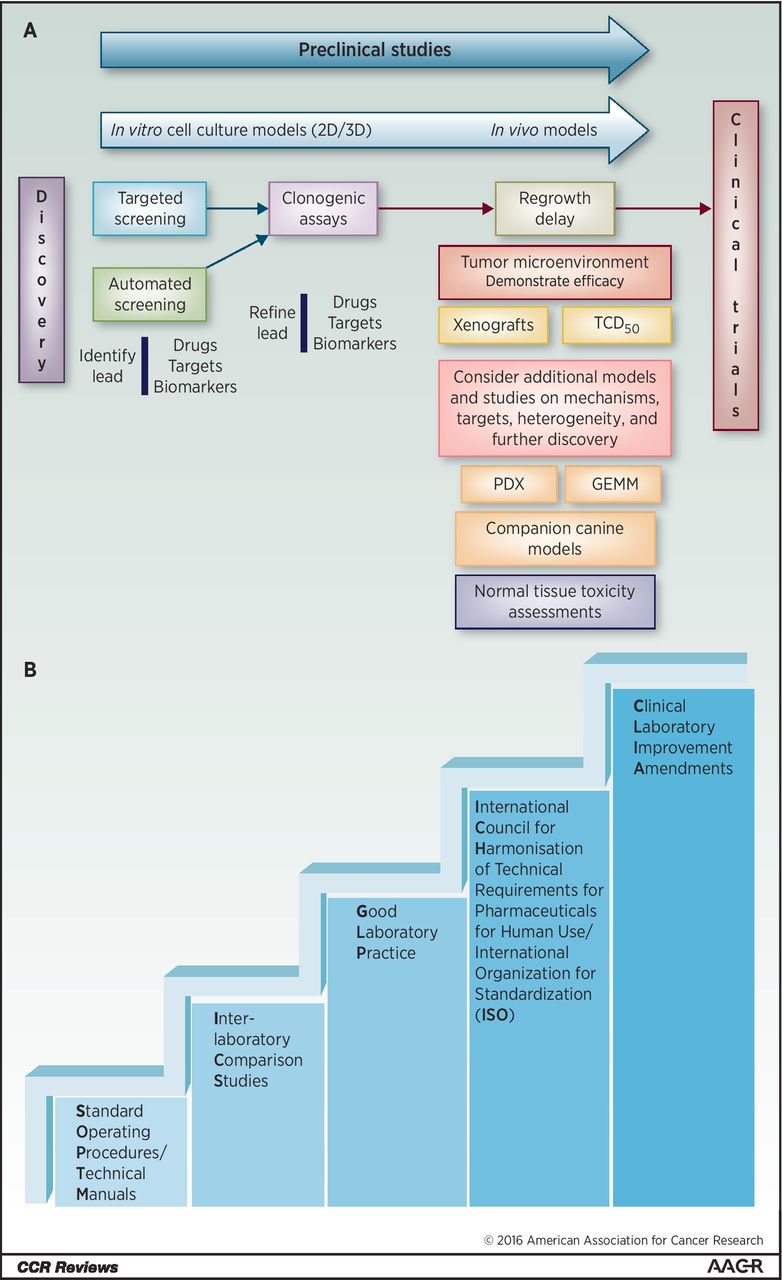(구)글로벌 핫이슈
방사선종양학
- 2016년 08월호
[Clin Cancer Res.] Improving the Predictive Value of Preclinical Studies in Support of Radiotherapy Clinical TrialsNational Cancer Institute / C. Norman Coleman*
- 출처
- Clin Cancer Res.
- 등재일
- 2016 Jul 1
- 저널이슈번호
- 22(13):3138-47. doi: 10.1158/1078-0432.CCR-16-0069. Epub 2016 May 6.
- 내용

Abstract
There is an urgent need to improve reproducibility and translatability of preclinical data to fully exploit opportunities for molecular therapeutics involving radiation and radiochemotherapy. For in vitro research, the clonogenic assay remains the current state-of-the-art of preclinical assays, whereas newer moderate and high-throughput assays offer the potential for rapid initial screening. Studies of radiation response modification by molecularly targeted agents can be improved using more physiologic 3D culture models. Elucidating effects on the cancer stem cells (CSC, and CSC-like) and developing biomarkers for defining targets and measuring responses are also important. In vivo studies are necessary to confirm in vitro findings, further define mechanism of action, and address immunomodulation and treatment-induced modification of the microenvironment. Newer in vivo models include genetically engineered and patient-derived xenograft mouse models and spontaneously occurring cancers in domesticated animals. Selection of appropriate endpoints is important for in vivo studies; for example, regrowth delay measures bulk tumor killing, whereas local tumor control assesses effects on CSCs. The reliability of individual assays requires standardization of procedures and cross-laboratory validation. Radiation modifiers must be tested as part of clinical standard of care, which includes radiochemotherapy for most tumors. Radiation models are compatible with but also differ from those used for drug screening. Furthermore, the mechanism of a drug as a chemotherapeutic agent may be different from its interaction with radiation and/or radiochemotherapy. This provides an opportunity to expand the use of molecular-targeted agents.
Author information
Coleman CN1, Higgins GS2, Brown JM3, Baumann M4, Kirsch DG5, Willers H6, Prasanna PG7, Dewhirst MW8, Bernhard EJ7, Ahmed MM7.
1Radiation Research Program, Division of Cancer Treatment and Diagnosis, National Cancer Institute (NCI), NIH, Bethesda, Maryland. ccoleman@mail.nih.gov.
2Cancer Research UK/Medical Research Council, Oxford Institute for Radiation Oncology, University of Oxford, United Kingdom.
3Department of Radiation Oncology, Stanford University School of Medicine, Stanford, California.
4OncoRay National Center for Radiation Research, Technische Universität Dresden/Helmholtz-Zenrtum Dresden-Rossendorf, Dresden, Germany and German Cancer Consortium, Dresden/German Cancer Research Center (DKFZ).
5Departments of Radiation Oncology and Pharmacology and Cancer Biology, Duke University, Durham, North Carolina.
6Department of Radiation Oncology, Massachusetts General Hospital, Harvard Medical School, Boston, Massachusetts.
7Radiation Research Program, Division of Cancer Treatment and Diagnosis, National Cancer Institute (NCI), NIH, Bethesda, Maryland.
8Departments of Radiation Oncology, Pathology and Biomedical Engineering, Duke University, Durham, North Carolina.
- 덧글달기
- 이전글 [J Clin Oncol.] Therapeutic Impact of Cytoreductive Surgery and Irradiation of Posterior Fossa Ependymoma in the Molecular Era: A Retrospective Multicohort Analysis
- 다음글 [Clin Cancer Res.] Androgen Deprivation Followed by Acute Androgen Stimulation Selectively Sensitizes AR-Positive Prostate Cancer Cells to Ionizing Radiation







